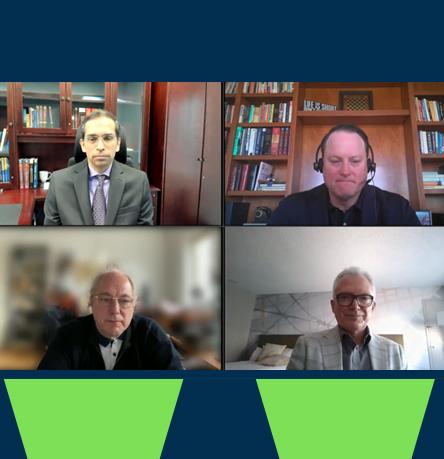
Authors: Rich Worldwide Clinical Trials Exec. Director, Therapeutic Strategy Lead, Neuroscience & Lucie Undus, MD PhD, Exec. Director, Therapeutic Area Medical Lead.
In the quest to shift ALS from terminal to treatable, we still have a long way to go. Since marketing authorization for the first breakthrough treatment in 1994, the steady increase in clinical trials reflects the community’s commitment to finding effective ALS treatments despite the numerous hurdles associated with clinical trial design, from proof-of-concept to pivotal trials. A wave of momentum stems from an increased scientific understanding of the underlying pathophysiology and technological advancements.
These advancements have fostered increased focus from politicians, policymakers, and the investment communities backing academic and industry-sponsored research projects. This trend is on the rise despite recent disappointments with clinical trial outcomes, which have the potential to destabilize the industry in the short term regarding drug development strategy and optimal study designs. The peak number of trials in the last five years and the regulatory approvals of three additional disease-modifying treatments for ALS in the previous eight years signal cause for hope that, as a community, we have the potential to transform this progressive and ultimately terminal neurodegenerative disorder into a treatable condition.
Currently Available Pharmacotherapies in the ALS Treatment Armory
The battle against ALS has seen the introduction of a limited number of approved pharmacological treatments combined with other essential areas of multidisciplinary care. Differences in regulatory sentiments and industry sponsors’ subsequent clinical development strategies historically restricted access based on geography. Disease modifying pharmacotherapies with marketing authorization in at least one regulatory jurisdiction include riluzole, edaravone, sodium phenylbutyrate and taurusodiol (PB-Turso), and tofersen.
| Compound | Notes | Approval Status | Basis for Approval |
|---|---|---|---|
| Riluzole (Oral) | This orally available neuroprotective agent has anti-glutaminergic properties and theoretically reduces excitotoxicity. It is now an established part of the standard of care for ALS; up to 95% of patients take riluzole. | Initial approval in 1994: FDA, U.S. Available across the globe | Established efficacy in two adequate and well-controlled trials. Survival curves were found to be significant when the Wilcoxon test was applied with patient observation period of at least 12 months. The Kaplan-Meier survival curves of study 2 showed that patients receiving riluzole experienced an early increase in survival. |
| Edaravone (IV Infusion) | Studies suggest the mechanism is free-radical elimination and modulating neuroinflammatory response to protect against oxidative stress. Dosing & Treatment Regimen: 14-day daily infusion (2 consecutive 30mL infusion bags over 60 minutes) then a 14-day drug-free period Subsequent treatment cycles of dosing for 10 days out of 14 days, followed by a 14-day drug-free period | Initial approval in 1997: PDMA, Japan Available in selected regulatory jurisdictions such as Japan, Canada, and U.S. | Researchers established efficacy of edaravone in a 24 week, randomized, placebo-controlled double-blind study in 137 Japanese patients. The primary endpoint was a comparison between the treatment arms of the change from baseline and week 24 in the ALSFRS-R. The treatment difference was 2.49 (0.99 – 3.98) p=0.0013. The MAA file in the E.U. was withdrawn, rendering it unapproved for patient use, based on negative review comments by the Committee for Medicinal Products for Human Use. |
| Edaravone (Radicava ORS) (Oral) | The oral suspension uses the same active ingredient as the approved IV infusion for edaravone and may be taken orally or via a feeding tube. Dosing & Treatment Regimen: 105mg (5 mL) taken in the morning after overnight fasting. This is administered according to the same treatment regimen as for the IV infusion. | Initial approval in 2022: FDA, U.S. Available in selected regulatory jurisdictions such as Japan, Canada, and U.S. | Approval has been based on bioequivalence with the FDA stating that the effectiveness of Radicava ORS is based on a study showing comparable levels of Radicava ORS in the bloodstream to the levels from the IV formulation of Radicava. There were negative Phase 3 results from a study designed to fulfill EMA requirements. |
| Sodium Phenylbutyrate and Taurursodiol (PB-Turso) (Oral) | The proposed mechanism of the fixed-dose combination is for a synergistic effect on inhibiting neuron death via inhibiting endoplasmic reticulum and mitochondrial stress. Dosing & Treatment Regimen: 1 packet (3g phenylbutyrate + 1g taurursodiol) daily for the initial 3 weeks. Then 1 packet to be used twice daily thereafter. | Initial approval in 2023: FDA, U.S. For use in patients with a SOD1-ALS in the U.S | The efficacy of PB-Turso was demonstrated in a 24-week randomized, double-blind, placebo-controlled study in 137 patients. The primary endpoint was a comparison between the treatment arms of the change from baseline and week 24 in the ALSFRS-R. The treatment difference was 2.32(0.18 – 4.47) p=0.034. A post-hoc analysis of survival additionally supported this data. The Phase 3 study designed to fulfil EMA requirements was negative. |
| Tofersen (Intrathecal injection) | This is an antisense oligonucleotide (ASO) that targets SOD1 mRNA to reduce the synthesis of SOD1 protein. Dosing & Treatment Regimen: Administered as a 100mg (15mL) intrathecal injection. There are three initial doses at a 14-day interval followed by a maintenance frequency of administration every 28 days. | This was granted FDA Accelerated Approval based on changes in biomarkers interpreted as surrogate endpoints, which are reasonably likely to predict a clinical benefit. Data showed a reduction in neurofilament light levels (NfL), a blood-based biomarker of nerve injury and neurodegeneration, at week 28. Evidence of a mode of action/target engagement through a complementary reduction in SOD1 expression further supports these data. A condition of approval is the completion of a Phase 3 study designed to evaluate pheno-conversion in SOD1 mutation carriers (ATLAS study) to confirm clinical benefit. |
Current Landscape of Therapeutic Development: Horizontal Thinking, the Role of Advanced Therapies, and Novel Drug Candidates
While available treatments mainly rely on multidisciplinary care heavily focused on non-invasive respiratory care and nutritional support, clinical trials provide necessary access to investigative medicinal products on top of approved pharmacotherapy. According to Citeline, there are 160 ALS studies planned or ongoing in 2024 with various sponsors such as academia, consortia, government, and industry, not including studies in HV populations. This research community is exploring diverse therapeutic avenues and creative thinking, including gene therapies, cell therapies, immunotherapies, novel drug candidates, and the repurposing of drugs from other indications.
Master Protocols: A Route to Acceleration of Drug Development Projects
A platform trial uses a shared master protocol and operational infrastructure to test multiple regimens adaptively, thus enhancing trial efficiency. The shared placebo design is another approach to accelerating drug development in ALS research. This design tests multiple drugs using a single placebo group, thereby increasing the number of therapeutics evaluated while minimizing the number of participants receiving a placebo. Further, the HEALEY platform trial and the ENCALS/TRICALS Magnet master protocol are academic/clinical consortia-led study constructs that have received much attention from the patient community due to their association with reputable clinical consortia and community leaders, which has helped to accelerate recruitment and regimen readouts.
Moreover, exploring the repurposing of existing drugs offers additional pathways to potentially effective treatments through adopting a horizontal thinking-based approach. From drugs previously FDA-approved for gallstone diseases, Parkinson’s disease, and even cancer, researchers are working tirelessly to test and establish whether these pharmacotherapies with well-defined safety profiles may have any potential for efficacy in treating ALS.
Biotech Solutions: The Emergence of Various Cell, Gene, & Immunotherapy Options in ALS
One up-and-coming area of research is gene therapy, which broadly encompasses any therapeutics that add or edit genetic material. An area of interest has been deciphering ALS’s genetic underpinnings and delivering functional copies of dysfunctional genes to the patient. This approach is facilitated by developing ASOs and RNA interference (RNAi) therapies, which target the various molecular and genetic mechanisms contributing to ALS pathophysiology and disease progression. The targeted ASOs aim to downregulate the expression of gene mutations that are associated with gain-of-function toxicity that leads to motor neuron loss in some ALS cases.
Additionally, there are studies underway for a variety of ALS-implicated mutations, including:
- C9orf72 hexanucleotide repeat expansions
- ATXn2 trinucleotide expansions
- SOD1 inhibitor (siRNA and ASO)
- TDP43 inhibitor (ASO)
- Stathmin 2 agonist
- Calpain 2 inhibitor (ASO)
- Caveolin 1 stimulant (gene therapy)
- FUS mutations and some sporadic forms of unknown etiology
Collectively, the preliminary studies offer promise for future therapeutic development, likely drawing from multi-drug combinatorial approaches. Additional research is underway using gene editing via CRISPR, primarily investigating genes with known relationships to ALS, such as SOD1 and C9orf72. However, work is needed before CRISPR-mediated treatments become possible, including a better understanding of the genes involved in ALS. Other researchers are investigating approaches that use AAV-mediated trophic support and antibody-based therapies, such as vaccines and small molecule drugs, to modify various protein expressions.
There continues to be a significant appetite for cellular-based therapies within the ALS patient community with products tested, including human neural stem cells (hNSCs) and mesenchymal stem cells (MSCs) from bone marrow or adipose tissue. Additionally, researchers are investigating T-cell stimulants (Tregs) and cell-derived neurotrophic growth factor agonists.
Immunological therapies include humanized monoclonal antibodies with targets such as C1q inhibition, C5a inhibition, tubulin polymerization, inhibition, and CD20 antagonism, and targets related to proteinopathy such as cytotoxic SOD1 aggregates.
Pharmaceutical Solutions: A Continuing Role for Small Molecules
Beyond gene manipulation, cell treatments, and neuroimmunology, we are seeing novel small-molecule drug candidates that provide mechanisms of action related to specific pathological theories in ALS. For example, antioxidant-based treatments may counter the higher levels of oxidative stress in ALS patients. Another — iron accumulation removal-based drugs may have preliminary additive benefits to traditional antioxidant-based treatments, as excessive iron accumulation is associated with aging and higher oxidative stress. Regardless, the future holds promise; our understanding of ALS and our biological and technological capabilities are growing, and more scientists are tackling the problem from multiple angles and diverse mental frameworks. Indeed, there is a continuing trend towards combination products where treatments can target multiple complementary points within disease pathology.
A Hopeful Future
ALS is a complex neurodegenerative condition that remains ultimately fatal despite the continued advancements across all areas of multidisciplinary care. Improvements in vital care, such as ventilation and nutritional support, have been supplemented by other clinical disciplines, like physical and speech therapy. We are seeing enhanced quality of life through advancements in technology, helping people with ALS maintain independence through various modalities such as specialized wheelchairs and voice and eye scanning tools.
Despite the challenges related to ALS research, our advancement in understanding the disease and developing therapeutics is reaching new heights. The fight against ALS is a testament to human resilience and the relentless pursuit of scientific advancement. As we continue to explore current treatments and venture into new avenues of research, there lies hope for those affected by ALS. The opportunity to contribute to this progress has never been more critical for clinical researchers. For a more in-depth discussion on challenges and solutions to ALS research, read our blog.
Partnering with experienced and dedicated organizations in the ALS space, like Worldwide Clinical Trials, can help turn the promise of future therapies into reality, offering hope to patients and families waiting for a breakthrough. Together, we can navigate the complexities of ALS research and move closer to a world where ALS is no longer a terminal condition but a treatable one. Contact us today to discuss your study-specific needs and ensure your research is at the forefront of ALS investigations!



